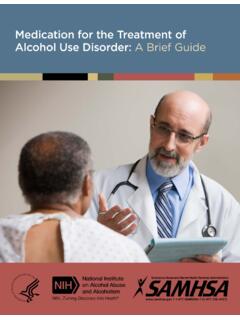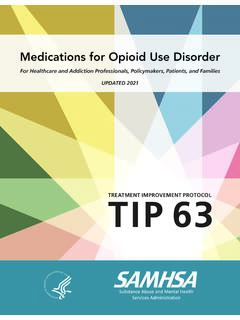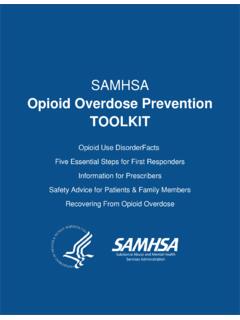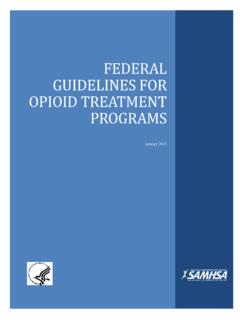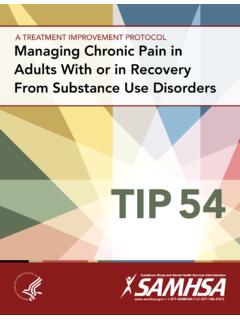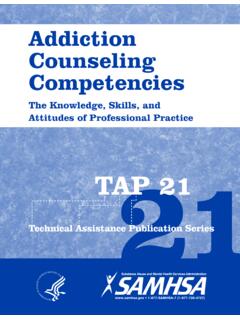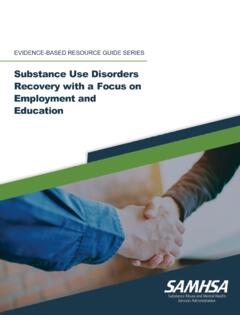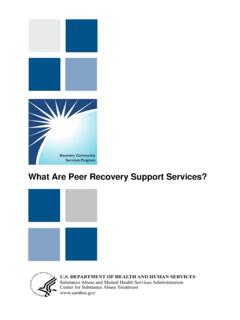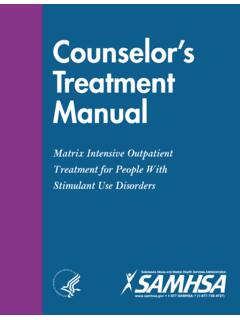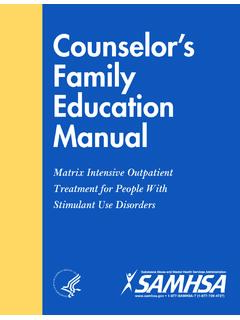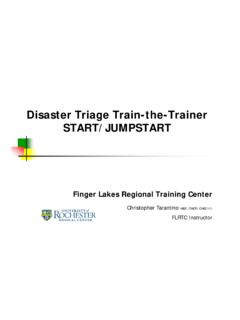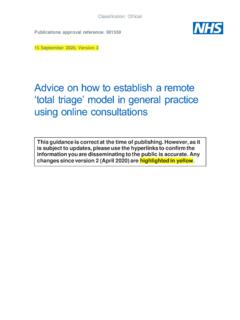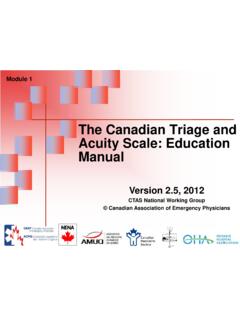Transcription of U.S. DEPARTMENT OF HEALTH AND HUMAN SERVICES
1 ResouRcesn n n n Download this card and additional resources at Resource for implementing The Joint Commission 2007 Patient Safety Goals on Suicide safe -T drew upon the American Psychiatric Association Practice Guidelines for the Assessment and Treatment of Patients with Suicidal Behaviors Practice Parameter for the Assessment and Treatment of Children and Adolescents with Suicidal Behavior. Journal of the American Academy of Child and Adolescent Psychiatry, 2001, 40 (7 Supplement): 24s-51sAcKNoWLeDGMeNTsn Originally conceived by Douglas Jacobs, MD, and developed as a collaboration between Screening for mental HEALTH , Inc. and the Suicide Prevention Resource This material is based upon work supported by the substance abuse and mental HEALTH SERVICES administration (SAMHSA) under Grant No.
2 1U79SM57392. Any opinions/findings/conclusions/recommenda tions expressed in this material are those of the author and do not necessarily reflect the views of Suicide Prevention Lifeline1-800-273-TALK (8255) Publication No. (SMA) 09-4432 CMHS-NSP-0193 Printed 2009 safe -TSuicide Assessment Five-step Evaluation and Triage1 IDeNTIFY RIsK FAcToRsNote those that can be modified to reduce risk2 IDeNTIFY PRoTecTIVe FAcToRsNote those that can be enhanced3coNDucT suIcIDe INQuIRYS uicidal thoughts, plans,behavior, and intent4 DeTeRMINe RIsK LeVeL/INTeRVeNTIoNDetermine risk. Choose appropriateintervention to address and reduce risk5 DocuMeNTAssessment of risk, rationale,intervention, and DEPARTMENT OF HEALTH AND HUMAN SERVICESS ubstance abuse and mental HEALTH SERVICES assessments should be conducted at first contact, with any subsequent suicidal behavior, increased ideation, or pertinent clinical change.
3 For inpatients, prior to increasing privileges and at RISK FACTORS 3 suicidal behavior: history of prior suicide attempts, aborted suicide attempts, or self-injurious behavior 3 current/past psychiatric disorders: especially mood disorders, psychotic disorders, alcohol/ substance abuse , ADHD, TBI, PTSD, Cluster B personality disorders, conduct disorders (antisocial behavior, aggression, impulsivity) Co-morbidity and recent onset of illness increase risk 3 Key symptoms: anhedonia, impulsivity, hopelessness, anxiety/panic, global insomnia, command hallucinations 3 3 Precipitants/stressors/Interpersonal: triggering events leading to humiliation, shame, or despair ( , loss of relationship, financial or HEALTH status real or anticipated). Ongoing medical illness (esp.)
4 CNS disorders, pain). Intoxication. Family turmoil/chaos. History of physical or sexual abuse . Social isolation 3 change in treatment: discharge from psychiatric hospital, provider or treatment change 3 Access to firearmsFamily history: of suicide, attempts, or Axis 1 psychiatric disorders requiring hospitalization2. PROTECTIVE FACTORS Protective factors, even if present, may not counteract significant acute riskInternal: ability to cope with stress, religious beliefs, frustration toleranceexternal: responsibility to children or beloved pets, positive therapeutic relationships, social supports3. SUICIDE INQUIRY Specific questioning about thoughts, plans, behaviors, intent Ideation: frequency, intensity, duration in last 48 hours, past month, and worst ever Plan: timing, location, lethality, availability, preparatory acts Behaviors: past attempts, aborted attempts, rehearsals (tying noose, loading gun) vs.
5 Non-suicidal self injurious actions Intent: extent to which the patient (1) expects to carry out the plan and (2) believes the plan/act to be lethal vs. self-injurious. Explore ambivalence: reasons to die vs. reasons to live 3 3 3 3 3 3 * For Youths: ask parent/guardian about evidence of suicidal thoughts, plans, or behaviors, and changes in mood, behaviors, or disposition * Homicide Inquiry: when indicated, esp. in character disordered or paranoid males dealing with loss or humiliation. Inquire in four areas listed above 3 3 4. RISK LEVEL/INTERVENTIONA ssessment of risk level is based on clinical judgment, after completing steps 1 3 Reassess as patient or environmental circumstances changeRISK LEVEL RISK/PROTECTIVE FACTOR SUICIDALITY POSSIBLE INTERVENTIONSHighPsychiatric diagnoses with severe symptoms or acute precipitating event; protective factors not relevantPotentially lethal suicide attempt or persistent ideation with strong intent or suicide rehearsalAdmission generally indicated unless a significant change reduces risk.
6 Suicide precautionsModerateMultiple risk factors, few protective factorsSuicidal ideation with plan, but no intent or behaviorAdmission may be necessary depending on risk factors. Develop crisis plan. Give emergency/crisis numbersLowModifiable risk factors, strong protective factorsThoughts of death, no plan, intent, or behaviorOutpatient referral, symptom reduction. Give emergency/crisis numbers(This chart is intended to represent a range of risk levels and interventions, not actual determinations.)5. DOCUMENT Risk level and rationale; treatment plan to address/reduce current risk ( , medication, setting, psychotherapy, , contact with significant others, consultation); firearms instructions, if relevant; follow-up plan. For youths, treatment plan should include roles for parent/guardian.
